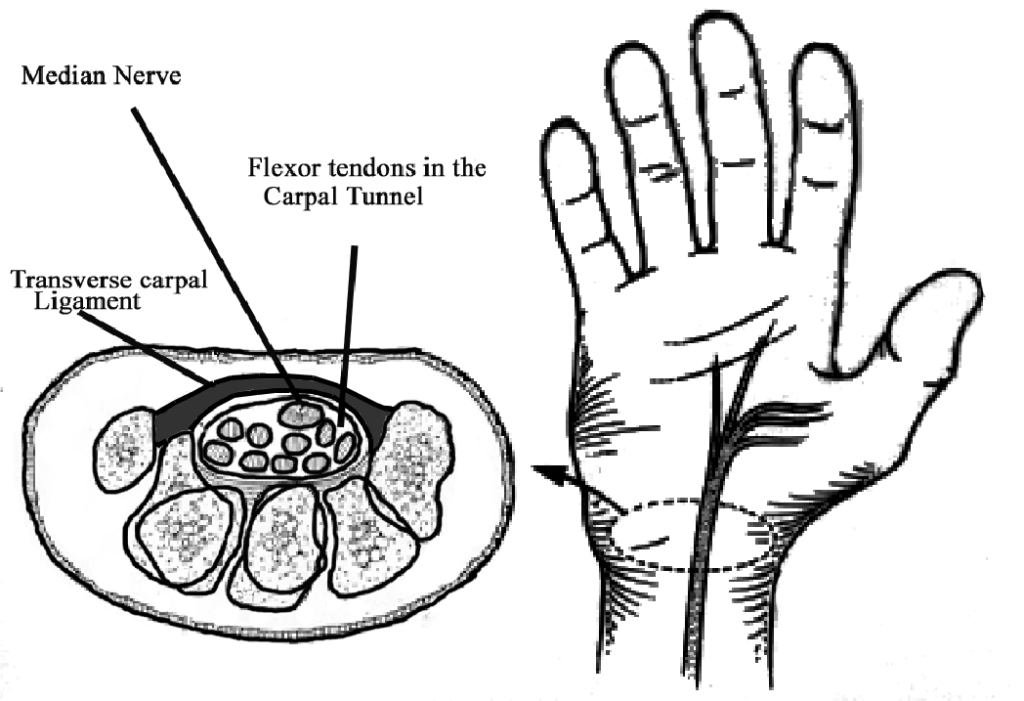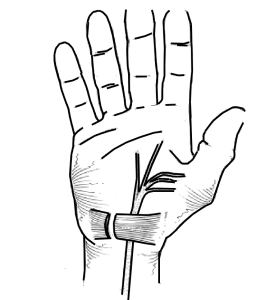Carpal Tunnel Syndrome
What is Carpal Tunnel Syndrome?
The carpal tunnel is a passageway in the wrist formed by the eight carpal (wrist) bones, which make up the floor and sides of the tunnel, and the transverse carpal ligament, a strong ligament stretching across the roof of the tunnel. Inside the carpal tunnel are the flexor tendons that bend your fingers and thumb to make a fist. The median nerve passes through the carpal tunnel and it is pressure on this nerve that causes carpal tunnel syndrome.
The median nerve supplies sensation (feeling) to the thumb, index & middle fingers, and half of the ring finger. It also supplies power to the muscle at the base of the thumb that allows you to pull your thumb towards your forearm. Increased pressure on the median nerve may result from narrowing of the carpal tunnel due to injury or arthritis. Thickening of the tendons inside the tunnel can also put pressure on the median nerve.


What are the causes of Carpel Tunnel Syndrome?
Most patients who develop carpal tunnel syndrome are healthy adults over the age of 40. It is more common in women. There is gradual thickening of the tendons in the carpal tunnel that can lead to median nerve compression. Carpel tunnel syndrome is also common in heavy manual workers and tradespeople.
Carpal tunnel syndrome is only considered work-related when ALL three of these factors are present:
- Repetitive strong grasp
- Vibrating tools
- Cold exposure.
Risk factors developing carpal tunnel syndrome:
- Diabetes
- Hypothyroidism
- Wrist fractures or injury to hand
- Pregnancy
- Gout
- Osteoarthritis or the wrist/base of thumb
- Smoking
- Rheumatoid/Psoriatic Arthritis
- High Body Mass Index
- Tumours (rare)
- A family history of carpal tunnel syndrome
What are the signs & symptoms?
The classic symptoms are numbness, burning or tingling of one or more fingers occurring at night. In younger adults often the only symptoms are vague pain and weakness. Aching, burning or electric pain may affect the hand, wrist, forearm and even radiate to the shoulder and neck. The symptoms are often worse with grasping activities such as lifting a weight or driving. In more severe cases, clumsiness, loss of dexterity and weakness can occur.
A positive Finkelstein’s test is usually present. In this test, the patient makes a fist with the thumb placed in the palm and bends the wrist. This test will cause pain in patients with de Quervain’s tenosynovitis.
How is it treated?
Most people will eventually require surgery as the natural course of carpal tunnel syndrome is to slowly get worse. Non-operative treatment of patients with mild symptoms usually involves use of a splint and avoiding repetitive activities. A cortisone (steroid) injection may greatly reduce the symptoms for a month or two. Surgical treatment is most often recommended as it is safe and reliable.
What is involved in the surgery?
 Carpal tunnel release is performed as a day surgery procedure under sedation with local anaesthetic or general anaesthetic. The procedure takes approximately 45 minutes. Expect to arrive at the hospital 2 hours before surgery and leave the hospital 2 hours after the surgery. The carpal tunnel release is performed through a 2.5cm skin incision at the base of the palm.
Carpal tunnel release is performed as a day surgery procedure under sedation with local anaesthetic or general anaesthetic. The procedure takes approximately 45 minutes. Expect to arrive at the hospital 2 hours before surgery and leave the hospital 2 hours after the surgery. The carpal tunnel release is performed through a 2.5cm skin incision at the base of the palm.
The ligament forming the roof of the tunnel is cut. This allows the tunnel to expand increasing the size of the tunnel by 20% to relieve the pressure on the median nerve. Dissolving stitches are used (unless you are diabetic) and a bandage
is wrapped around the palm and wrist. It is possible to use the fingers and thumb for light activities on the day of surgery. A long-acting local anaesthetic is injected which will make your hand numb for at least 6-8 hours.
What happens after the surgery?
When you go home your hand will be numb for many hours due to the anaesthetic. This will keep your pain to a minimum. Strong pain relief is usually only needed in the first 48hrs. The bandage must be kept clean and dry until you are able to remove the dressing as advised in the instructions given to you on the day of surgery. You may use your hand for light activities.
What about recovery?
5-7 days: Most people will be able to drive & return to light clerical duties with regular panadol osteo to control discomfort.
2 weeks: Stitches will be removed & you can shower without a plastic bag.
3-4 weeks: There will be sharp pain or mild ache if you do too much.
6-8 weeks: You will have a progress review with the surgeon. All light daily activities should now be possible. The scar will be quite thick and tender. This will take 4 months to resolve.
3-4 months: Most people are pain free and feel that their grip strength is normal. Improvements in strength and sensation depend on the how severely the nerve was injured before surgery. Recovery of a severely compressed nerve can take up to 2 years.
Heavy manual workers may not return to work for 2-4 weeks and shall be on restricted duties for approximately 12 weeks.
What are the risks?
Recurrence – 5% risk of recurrence in older patients, but younger adults are likely to require a repeat carpal tunnel release during their working life.

